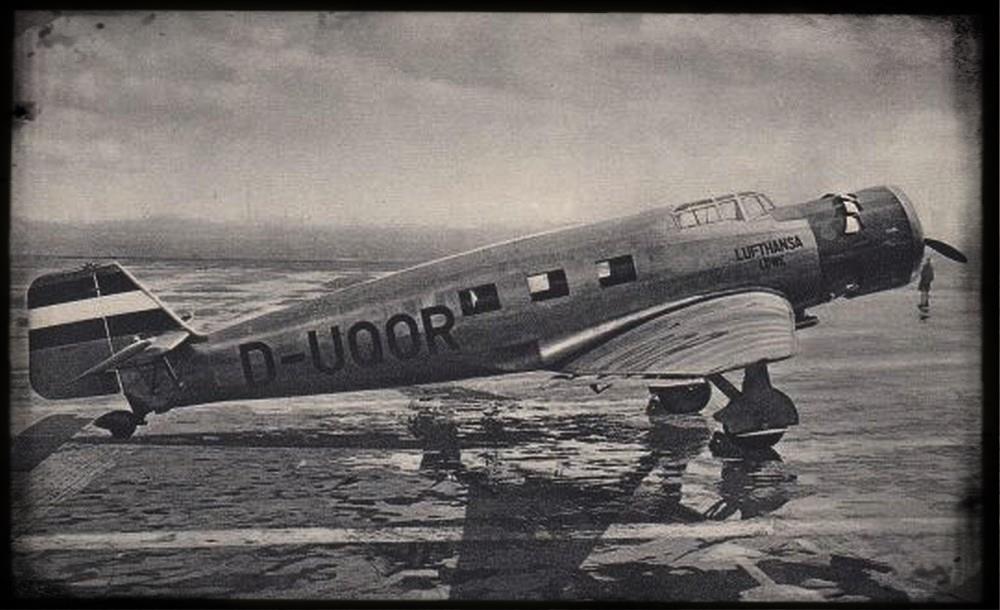Junkers Ju60
see also: Junkers Ju60 Production List / Junkers Ju60 Model Kits
civil cantilever monoplane airliner, 6 passengers, 2 x Ju 60 and 18 Ju 160 built,
F/F Ju 60: 08.11.1932, Ju 160: 30.01.34, designed by Pohlmann 
Junkers Ju60
In 1931 the Ju 60 was started as the last Junkers design, influenced by Hugo Junkers himself. This developement was initiated by the Lockheed Vega, a fast passenger airliner from the USA, which achieved speeds normally known from quick fighter aircraft. The Lockheed Vega and the later Lockheed Orion settled new standards in the area of air transport regarding passenger convenience and travelling speed. The need for new aircraft designs in Germany became obvious by these modern passenger airliners. The RVM advised Junkers Flugzeugwerke, as well as Heinkel to start the developement of a competitive German aircraft for Lufthansa.
The developement of the Ju60 is done under the designator EF30. Three different designs are discussed, a mediumlever monoplane with corrugated Duralumin wings, a cantilever monoplane, also with corrugated Duralumin wings and a single-wheel undercarriage and a cantilever monoplane with smooth metal wing. Pohlmann also investigated a twin and three engine version. The cantilver monoplane version with the smooth metal wing showed the best performance and a speed of 340km/h was promised with this design. Nevertheless, Eduard Milch, who was chairman of Lufthansa, favorized the corrugated version and a retractable undercarriage.
On November, 8th 1932 the Ju60V1 was first flown by Willy Neuenhofen. One month later the Heinkel He70 flew first. Both aircraft were compared by Lufthansa, which finally ordered the Heinkel He70, which reached about 360km/h compared to 285km/h of the Ju60. Just two Ju60 were built. A third was under construction, when the programme was aborted. While the Ju52 was the last Junkers aircraft, which was completely built with corrugated structures, the Ju60 was the last Junkers aircraft, which at least partially utilized corrugated structures.

Junkers Ju160
Following the Lufthansa decision for the He70, Pohlmann continued to improve the Ju60 design. He returned to the much more promising smooth wing and redesigned the complete fuselage structure. This new design was designated as Ju 160. On January, 30th 1934 the Ju160 was first flown. Like the Heinkel He70, the Junkers Ju160 was able to reach a maximum of 340 km/h. Lufthansa was now interested in this design and ordered a total of 18 aircraft with the support of the RLM following a test period with the prototype in 1936. The serial aircraft were delivered to Lufthansa in 1937. Lufthansa used the Ju160s on the Blitz-routes from Germany to Zurich until 1941, when the aircraft were transfered to Luftwaffe.
Technical Data:
| Aircraft | year | engine | length in m | span in m | wing area im sqm | net weight in kg | payload in kg | seats | speed in km/h | range in km |
|---|---|---|---|---|---|---|---|---|---|---|
| Ju60ba, b1a | 1931 | BMW Hornet A2 (440kW) *) | 11,84 | 14,30 | 34,00 | 2040 | 1060 | 2 pilots + 6 pass. | 285 | 1000 |
**) The Ju 160D0 was equipped with BMW132E2 (478kW). Most D0 were modified B0 and C0 aircraft.
Weblinks:
- Airwar.ru - Ju60 Story, Data, Photos
- Airwar.ru - Ju160 Story, Data, Photos
- Junkers.de - Ju60 Story, Data
- Fliegerweb.com - Ju160 Story, Data, Photos
- Wikipedia.org - Ju60 Story, Data
- Wikipedia.org - Ju160 Story, Data
- Klassiker-runde-Wetterau.com - Ju160 Story, Photos
- Histaviation.com - Ju60/160 Serials, here is the Story
Literature:
- H. Pohlmann
Das Schnellverkehrsflugzeug "Junkers Ju160"
in: Zeitschrift des VDI, 06.04.1935, Bd. 79, Nr. 14
Download PDF here: Bochumer-bunker.de
introduced Jul 1996, transfered Jul 2017
http://hugojunkers.bplaced.net/
contents last updated 2 Mar 2002

